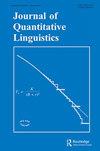基于完整和扭曲文本的Zipf–Mandelbrot分布中的最优文本大小现象研究。Hapax Legomena的作者频率特征及其推导
IF 1.7
2区 文学
0 LANGUAGE & LINGUISTICS
引用次数: 0
摘要
摘要本文探讨了在考虑文本长度、作者身份和文本随机失真时的词频模式。通过一系列实验,我们确定了最佳文本大小,这是乔治·齐普夫预测的一种现象,它可以看到计算频率和观测频率之间的最小差异。一个图形表示允许对这一现象的存在进行合理的解释。基于扭曲文本可能违反齐普夫定律的假设,我们探讨了与文本扭曲相比,频率和文本整体之间的相关性。结果揭示了文本长度对保持齐普夫分布的关键作用:随机选择的单词集和最佳大小的零碎文本仍然遵循齐普夫定律。研究结果表明,作者身份通过作者常数表现出来,作者常数被定义为最频繁单词的相对频率,在任何给定作者的作品中都保持不变,包括随机选择的不同大小的文本块和句子片段。本文章由计算机程序翻译,如有差异,请以英文原文为准。
Study of Optimal Text Size Phenomenon in Zipf–Mandelbrot’s Distribution on the Bases of Full and Distorted Texts. Author’s Frequency Characteristics and derivation of Hapax Legomena
ABSTRACT This paper explores word-frequency patterns when considering text length, authorship, and random distortion of texts. Through a series of experiments, we determined an optimal text size, a phenomenon that was predicted by George Zipf, which sees a minimal discrepancy between calculated and observed frequencies. A graphic representation allowed a plausible explanation behind the existence of this phenomenon. Working on the assumption that distorted texts might disobey Zipf’s Law, we explored correlations among frequencies and text entirety compared with text distortions. Results reveal the crucial role of text length for maintaining Zipfian distribution: randomly chosen sets of words and fragmentary texts of optimal size still obey Zipf’s Law. Findings show that authorship manifests itself through the author constant, defined as the relative frequency of the most frequent words, which remains constant throughout the works of any given author, including randomly chosen text chunks and fragments of sentences of various sizes.
求助全文
通过发布文献求助,成功后即可免费获取论文全文。
去求助
来源期刊

Journal of Quantitative Linguistics
Multiple-
CiteScore
2.90
自引率
7.10%
发文量
7
期刊介绍:
The Journal of Quantitative Linguistics is an international forum for the publication and discussion of research on the quantitative characteristics of language and text in an exact mathematical form. This approach, which is of growing interest, opens up important and exciting theoretical perspectives, as well as solutions for a wide range of practical problems such as machine learning or statistical parsing, by introducing into linguistics the methods and models of advanced scientific disciplines such as the natural sciences, economics, and psychology.
 求助内容:
求助内容: 应助结果提醒方式:
应助结果提醒方式:


